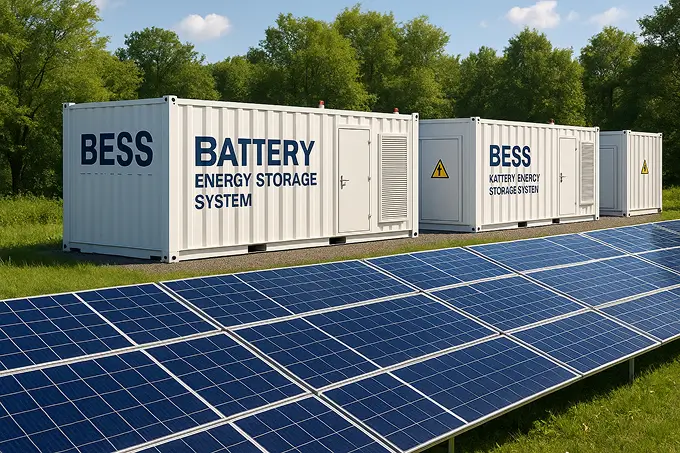Predictive Battery Analytics in The Energy Sector
Battery storage is a fundamental part of the energy sector. Batteries, however, are complex systems. Deriving the maximum profit from them without incurring any additional risk is the overarching goal of most energy operators. This is where battery analytics can help.

Maximizing Your Battery Storage Potential
Battery storage is a fundamental part of the energy sector. Batteries, however, are complex systems. Deriving the maximum profit from them without incurring any additional risk is the overarching goal of most energy operators. This is where battery analytics can help.
A total of 25 GWh is already installed in battery storage globally. This amount is predicted to reach up to 900 GWh by 2030. Batteries are an excellent solution to the challenges of the energy transition for several reasons. Compared to most other power plant technologies, batteries do not only generate energy – they also store it and boast reaction times of only milliseconds. Far from in theory alone, these characteristics make them suitable for numerous use cases, both front-of-the meter and behind-the-meter.
In practice there are many considerations: beside the enduringly high purchasing cost of batteries, there is also their complexity and individual aging behavior. This presents three main issues: multi-use applications, warranty management and the oversizing of batteries. With battery analytics, these difficulties can all be addressed, making battery storage a very attractive technology.
Low profitability and long amortization times– multi-use applications are the key
Pressure on margins and long amortization periods of battery storages are two of the basic challenges facing operators. High purchasing costs and fluctuating, unpredictable energy prices, compounded in the last few years by sinking prices on the PFR market, make the topic explosive. It is clear to many operators that nothing would work without multi-use applications.
The complex aging behavior of batteries makes the optimization and selection of the most profitable operating strategy via different potential uses difficult. Many operators shy away from multi-use applications because of this, without even being aware of the cost of battery aging. A continual use of the TWAICE Operating Strategy Planner can generate value for the customer in a wide variety of ways:
- Considering battery aging when planning operating strategies helps the operator to better decide between different strategies and timetables. This way, they can choose the optimal operating strategy for their business case, balancing the expected profits and battery lifetimes.
- An estimation of the aging costs per cycle and energy quantity can be incorporated into market optimization and price planning for various operating types. Lucrative operating modes, such as intraday trading or PCR, can be increased.
- Furthermore, the operator is secure in the knowledge that the storage can be used throughout the planned duration for the strategy they have selected. The risk of a premature storage outage is thereby minimized.
More efficient warranty management using battery analytics
Integrators face the challenge of combining multiple subcontractors’ guarantees into a system warranty for the end consumer. This not only takes place in the form of a conventional product guarantee (the storage system is not working any more) but also primarily in the form of a performance guarantee (the storage system delivers a specific performance over a specified period, e.g., the system capacity is at 80% SOH after ten years of run time). In the event of damage, the operator can access all necessary data with just a click of a button, thereby limiting the damage, minimizing risk, and saving money.
Storage operators also have the option of setting alerts that prevent the system from operating outside the warranty conditions or avoid inappropriate approaches. For example, this helps avoid elevated temperatures, especially lots of cycles, but also specific depths of discharge.
Oversizing of batteries and laborious development – optimize storages with simulation models
There is optimization potential in the development phase, not only in operation. Every battery engineer knows what oversizing is. To make sure that batteries deliver the agreed performance over the entire runtime, they are made larger than is necessary to allow for the expected aging and/or accompanying yet unpredictable loss of capacity. Combined with time intensive development, oversizing can lead to a battery design that is much costlier than it should be.
Battery simulation models, such as those in the TWAICE battery model library, present the ideal way to design the optimum battery for specified load profile, performance capability and storage capacity. This can lower capital costs significantly. Battery analytics and stress factor analyses can be deployed to monitor and observe batteries that are already in use. Conclusions drawn from the analyses help operators to design the next generation of batteries in an even more effective way.
The future of the energy sector is now unimaginable without batteries. They are complex, yes, but do not have to pose opaque risks. With the help of holistic battery analytics, players along the entire value chain – operators, owners, and project developers of battery storages – can meet their challenges and develop optimum batteries, operate, and generate the maximum potential from these storage units.
Sign up for the next live group demo and learn how TWAICE can transform your BESS operations. In just 30 minutes, you’ll get a demo of key features and use cases, and engage with our product experts for a live Q&A.


.avif)

.avif)
